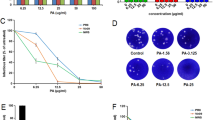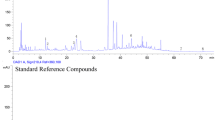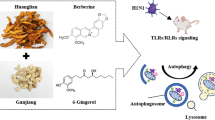Abstract
Patchouli alcohol (PA) is a kind of methanol extracted from traditional Chinese medicine Pogostemonis Herba. Our research aimed to observe the anti-influenza virus role of PA in vitro. 16HBE (human respiratory epithelial cell) was infected by H1N1 (A/FM1/1/47) to set the cell model. Then the 16HBE was co-cultivated with three kinds of immune cells: dendritic cells, macrophages, and monocytes, PA (the concentration is 10 μg/mL) was added as a treatment intervention for 24 h. The immune cells and the supernate were collected for RT-PCR and ELISA detection related to RLH (RIG-1-like helicases) pathway. Results showed that the IL-4 and IFN-γ in supernate were increased after H1N1 infection, and the PA treatment suppressed the expression of cytokines and the mRNA of RLH pathway. PA anti-influenza virus may through regulate the RLH singal pathway.
Graphical Abstract






Similar content being viewed by others
References
Williams Jason R, Po-Yen Chen, Cho Cheng T, Chin Tom DY (2008) Influenza: prospect for prevention and control. Kaohsiung J Med Sci 18(9):421–434
Butler D (2009) Alarms ring over bird flu mutations. Nature 439(19):248
Mungall Bruce A, Xi-yan Xu, Klimov Alexander (2002) Surveillance of influenza isolates for susceptibility to neuraminidase inhibitors during the 2000–2002 influenza seasons. Virus Res 103:195–197
Bhatia SP, Letizia CS, Api AM (2008) Fragrance material review on patchouli alcohol. Food Chem Toxicol 46(11):S255–S256
Li Yu-Cui, Xian Yan-Fang, Ip Siu-Po, Zi-Ren Su, Ji-Yan Su, He Jing-jin, Xie Qing-Feng, Lai Xiao-Ping, Lin Zhi-Xiu (2011) Anti-inflammatory activity of patchouli alcohol isolated from Pogostemonis Herba in animal models. Fitoterapia 82(8):1295–1301
Li Yu-Cui, Peng Shao-Zhong, Chen Hai-Ming, Zhang Feng-Xue, Pei-Ping Xu, Xie Jian-Hui, He Jing-Jin, Chen Jian-Nan, Lai Xiao-Ping, Zi-Ren Su (2012) Oral administration of patchouli alcohol isolated from Pogostemonis Herba augments protection against influenza viral infection in mice. Int Immunopharmacol 12(1):194–301
Bradford Bowzard J, Ranjan Priya, Sambhara Suryaprakash, Fujita Takashi (2009) Antiviral defense: RIG-lng the immune system to STING. Cytokine Growth Fact Rev 20(1):1–5
Luke Jeremy M, Simon Gregory G, Soederholm Jonas, Errett John S, August Thomas, Gale Michael Jr, Hodgson Clague P, Williams James A (2011) Coexpressed RIG-I agonist enhances humoral immune response to influenza virus DNA vaccine. J Virol 85(3):1370–1383
Takeuchi Osamu, Akira Shizuo (2008) MDA5/RIG-1 and virus recognition. Curr Opin Immunol 20(1):17–22
Kiyohara Hiroaki, Ichino Chikara, Kawamura Yuka, Nagai Takayuki, Sato Noriko, Yamada Haruki (2011) Patchouli alcohol: in vitro direct anti-influenza virus sesquiterpene in Pogostemon cablin Benth. J Nat Med 66(4):583–590
Combadiere B, Siberil S, Duffy D (2010) Keeping the memory of influenza viruses. Pathol Biol (Paris) 58:e79–e86
Stephenson I, Nicholson KG (1999) Chemotherapeutic control of influenza. J Antimicrob Chemother 44:6–10
Zhang L, Cheng YX, Liu AL, Wang HD, Wang YL, Du GH (2010) Antioxidant, anti-inflammatory and anti-influenza properties of components from Chaenomeles speciosa. Molecules 15(11):8507–8517
Choi HJ, Kim JH, Lee CH, Ahn YJ, Song JH, Baek SH, Kwon DH (2009) Antiviral activity of quercetin 7-rhamnoside against porcine epidemic diarrhea virus. Antiviral Res 81(1):77–81
Levita J, Nawawi A, Mutalib A, Ibrahim S (2010) Andrographolide: a review of its anti-inflammatory activity via inhibition of NF-kappaB activation from computational chemistry aspects. Int J Pharmacol 6:569–576
Levita J, Widiastuti NM, Nugrahani I, Musadad A, Nawawi A, Mutalib A, Ibrahim S (2011) Indirect iodination on the vinyl double bond of andrographolide. Int J Chem 3:p47
Thompson Alex JV, Locarnini Stephen A (2007) Toll-like receptors, RIG-1-like RNA helicases and the antiviral innate immune response. Immunol Cell Biol 85:435–445
Hornung V, Ellegast J, Kim S, Brzozka K, Jung A, Kato H, Poeck H, Akira S, Conzelmann KK, Schlee M, Endres S, Hartmann G (2006) 5′-Triphosphate RNA is the ligand for RIG-I. Science 314(5801):994–997
Saha SK, Pietras EM, He JQ, Kang JR, Liu SY, Oganesyan G, Shahangian A, Zarnegar B, Shiba TL, Wang Yao, Cheng GH (2006) Regulation of antiviral responses by a direct and specific interaction between TRAF3 and Cardif. EMBO J 25(14):3257–3263
Kawai T, Akira S (2007) Antiviral signaling through pattern recognition receptors. J Biochem (Tokyo) 141:137–145
Acknowledgments
This study was supported by the National Natural Science Foundation of China (No. 30973693, No. 81273616) and the Research Fund for the Doctoral Program of Higher Education of China (No. 20104401110003).
Author information
Authors and Affiliations
Corresponding author
Additional information
Xian-Lin Wu and Da-Hong Ju contributed equally to this article.
Rights and permissions
About this article
Cite this article
Wu, XL., Ju, DH., Chen, J. et al. Immunologic Mechanism of Patchouli Alcohol Anti-H1N1 Influenza Virus May Through Regulation of the RLH Signal Pathway In Vitro. Curr Microbiol 67, 431–436 (2013). https://doi.org/10.1007/s00284-013-0381-y
Received:
Accepted:
Published:
Issue Date:
DOI: https://doi.org/10.1007/s00284-013-0381-y




